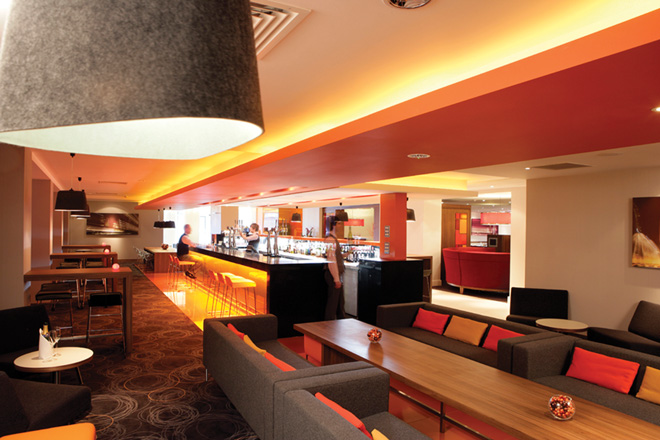With a product offering characterised by clean, contemporary lines, one would be forgiven for thinking that Hitch Mylius is a Scandinavian brand. This is, however, far from the case. With a factory and headquarters in Enfield, Hitch Mylius has its feet firmly planted on British soil. Hospitality Interiors’ Katie Sherry speaks with Hitch Mylius director, Ian Ashley, about why the simplest designs can be the most difficult to achieve, working with some of the world’s most prominent furniture designers, and why people should buy British.
When designers Tristram and Hazel Mylius founded Hitch Mylius in 1971, many people turned to the Continent – to Scandinavia and Italy in particular – for quality modern upholstered furniture. Hitch Mylius was one of the first British manufacturers to really make its mark in this field, and – despite some bouts of economic difficulty in the UK – has maintained its stance on craftsmanship and design ever since.
Simplicity really is a keyword in the Hitch Mylius design dictionary. Opting for strong shapes and bold colours over embellished and somewhat fussy designs, the company’s furniture stands out for its understated elegance. “For me, good design is well-proportioned, beautiful and uncomplicated,” Ian says.
It is a general rule of thumb that the most simple of designs are often the most complicated to make. This is a reality that Hitch Mylius has not only learned to cope with, but embraced. “It is the quality of our furniture that really stands out,” Ian explains.
“There is no room for error. If you have a very complicated design there are a lot of ways in which you can hide mistakes, but for us this is not the case. With our designs everything has to be perfectly aligned - the joints between the legs and seat, the curve in the back, the seams where the pieces of fabric meet.”
“For me, good design is well-proportioned, beautiful and uncomplicated”
All Hitch Mylius furniture is made at the company’s Enfield factory – much of it by hand. The upholstery fabric is hand measured and cut to allow for differences in stretch, and each furniture piece is fitted together with the utmost care. Attention to quality is paramount in even the smallest details – a wide range of threads, for example, has been collected over the years to allow for the exact colour of seam required.
For Ian, Hitch Mylius’ manufacturing expertise is one of the key things that makes the brand such a quality British manufacturer – and is something he would like to see much more of in the UK. “There is a prestige to buying British because of the quality,” Ian explains. “We have some of the best design talent in the world. The opening ceremony and architecture of the Olympics proved this – creative talent completely overwhelmed the financial input at Beijing.
“Quality manufacturing is the best thing that we can export, and we need to capitalise on the biggest skills we have. This is not necessarily the case for mobile phones and plastic toys – the world has already established China as the main exporter of this type of product, and this is not what we’re good at. But for high-end design, Britain has real expertise and talent to offer.”
Hitch Mylius’ manufacturing capabilities makes it the ideal partner for like-minded designers. The company collaborates with designers on a regular basis, and although Ian is quick to point out that the selection process is not elitist – “if we like the product, we’ll make it” – all new ranges have to fit with the Hitch Mylius signature style.
“There is a prestige to buying British . . . We have some of the best design talent in the world”
As such, Tristram still has ultimate control over the designs of all furniture produced, and personally works with the designers to create the perfect fit. “Designer collaborations work,” Ian says, “because of the mix of creativity with the sensible business side. Together, we take wild ideas and focus them into a finished product.”
Collaborations with designers – including Nigel Coates, Kenneth Grange and Kazuko Okamoto – have produced some of Hitch Mylius’most well-known and innovative products. One of the first ranges released in this way was David Chipperfield’s hm991 in 1999, which was followed with hm93 in 2007. “David’s design style fits with the Hitch Mylius’ manufacturing style – lots of linear, crisp edges,” Ian says.
Another successful collaboration was with Simon Pengelly, a designer known for his understated and innovative approach. Simon is one of the designers that Hitch Mylius has worked with the most, and together they have produced three ranges – hm83, hm85 and hm86. “Simon is an absolute delight to work with,” Ian says. “He has brilliant ideas, but can also take on board other people’s ideas. He’s very hardworking as well.”
Hitch Mylius’ focus on quality design and manufacturing – alongside its personable and efficient customer service – is its key selling point when it comes to being specified for hospitality venues. Past projects include Mint hotels in Amsterdam, Leeds and London; the Das Triest hotel in Vienna; and Hilton and Novotel hotels throughout the UK. Not one to rest on its laurels, Hitch Mylius has projects coming up further afield in Mumbai and Abu Dhabi, as well as a new multi-functional product launch in the pipeline – watch this space!



